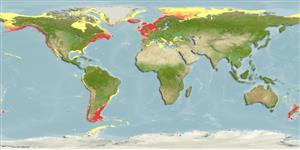Common names from other countries
Environment: milieu / climate zone / depth range / distribution range
Ekologi
; kisaran kedalaman 0 - 380 m (Ref. 83435). Temperate; 85°N - 57°S, 180°W - 43°E
Arctic, Atlantic, Eastern Pacific and the Mediterranean Sea. Subtropical to polar.
Length at first maturity / Size / Weight / umur
Maturity: Lm ? range ? - ? cm Max length : 10.0 cm TL jantan/; (Ref. 7726)
Assumed maximum length from Ref. 822. Known from intertidal to deep waters, in large aggregations of thirty or more individual adults (Ref. 7726). Free-living (Ref. 3123). Generally for group, planktonic and minute detrital food items through either suspension or deposit feeding (Ref. 87872). Feeds on various sea anemones (Ref. 822), particularly frilled anemone (Ref. 7726).
Life cycle and mating behavior
Kematangan | Reproduksi, perkembang biakan | Pemijahan | telur-telur | Fecundity | Larva
Sexes are separate but are seldom conspicuously different externally, simultaneous hermaphrodites yet self-fertilization is prevented due to various morphological, physiological, or behavioral mechanisms; generally, marine gastropods shed their eggs (Ref. 87872).
rujukan utama
Acuan | Koordinator | mitra
Turgeon, D.D., J.F. Quinn Jr., A.E. Bogan, E.V. Coan, F.G. Hochberg, W.G. Lyons, P.M. Mikkelsen, R.J. Neves, C.F.E. Roper, G. Rosenberg, B. Roth, A. Scheltema, F.G. Thompson, M. Vecchione and J.D. Willams. 1998. (Ref. 1667)
Status IUCN Red List (Ref. 130435)
status CITES (Ref. 108899)
Not Evaluated
Not Evaluated
penggunaan manusia
| FishSource |
Alat, peralatan
informasi lanjut
Umur / Saiz
Pertumbuhan
panjang-berat
panjang-panjang
Morfologi
Larva
Kelimpahan
Sumber internet
Estimates based on models
Preferred temperature
(Ref.
115969): 2.4 - 11.8, mean 7.2 (based on 1479 cells).
keancaman
Low vulnerability (10 of 100).
kategori harga
Unknown.
